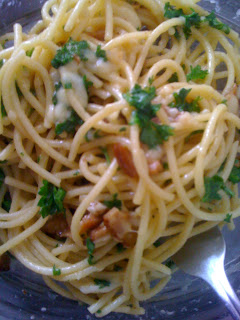Cranberry, Honey, and Ginger Biscotti
I made this biscotti for the Partners in Giving (our workplace charitable giving campaign) silent auction and bake sale. Mine contained crystallized ginger, cranberries, and honey, but there are tons of variations on this thrice-baked Italian cookie.
 |
| Aren't they pretty? |
2 c. flour (For baking, I usually use whole wheat pastry flour instead of bleached white flour. It's not as heavy and drying as regular whole wheat flour, but adds more nutrition than the white.)
1 tsp. baking powder
1/4 tsp. salt
1 c. sugar
2-3 eggs (It calls for 2 eggs and 1 egg white, but unless it's absolutely necessary, I don't separate eggs. I hate having leftover egg components because they usually go bad before I can use them.)
1 c. sugar (I use brown, rather than white.)
generous swirl of honey
~ 1 c. Craisins
~ 1 c. finely chopped crystallized ginger
Preheat oven to 350. Mix dry ingredients and wet ingredients separately, and then combine together. Mix until smooth, then transfer dough to a baking sheet, and shape into 2 logs, measuring about 12 inches long and 4 inches wide. Bake 25-30 mins. Reduce the oven temperature to 325. Cut the logs into 3/4-inch slices, turn the slices cut side down, and bake for 10 mins. Flip the slices and bake for 10 more mins. The result should be a gloriously crispy, somewhat sweet treat perfect for dunking into your cappuccino.
Spinach, Mushroom, and Feta Pizza with Phyllo Crust
I made this to use up the large box of phyllo dough in my freezer, although some of it still resides in the frozen depths. (It's from the half-successful Nigella's chicken pot pie experiment.) As is generally the case if you have a crust consisting of flaky phyllo lathered with butter, it was decadently yummy. The phyllo was a little destroyed from being defrosted and refrozen too many times, so I layered strips of it in alternating directions, brushing each layer with melted butter, until I had a thick crust. Then I topped it with sliced cremini mushrooms and spinach. I used a recipe from Epicurious.
Spaghetti Carbonara
Jason took the culinary helm on this effort, and I was the kitchen helper. I'd never had this before, but I was blown away by its fantastic flavor. I think this recipe from Amateur Gourmet was the one we used.
 |
| Spaghetti carbonara |
Here, leftover curried sweet potatoes that I wasn't terribly impressed with in the beginning were transformed into a lovely soup. A spin with the stick blender and the addition of some garlic chicken sausage from Trader Joe's made all the difference.
 |
| Sweet potato soup with garlic chicken sausage and a dollop of yogurt |
I've made this dal, originally from Cooking Light, several times now, and it's always satisfying.
 |
| The last of the red lentil dal |
 |
| Ribollita |
 |
| While the ribollita cooked, I indulged in smoked gouda on Triscuits with black olives...and a glass of red wine. |







